2023 年 63 巻 11 号 p. 1854-1862
2023 年 63 巻 11 号 p. 1854-1862
A CFD-PBM coupled mathematical model was proposed to describe the bubble breakup and coalescence behavior in gas-stirred ladle based on the Eulerian-Eulerian approach. The effect of turbulence shear collision, bubble floating velocity difference collision and turbulence random collision on the bubble coalescence behavior were considered; the sensitivity of three typical breakup model including Luo model, Lehr model and Laakkonen model on bubble size distribution were considered. The result showed that the turbulence random collision and bubble floating velocity difference collision were the main mechanism to affect bubble coalescence behavior, while the effect of turbulence shear collision can be ignored. The bubble size distribution predicted by Lehr model was different with other two models and the measured data, because it highly predicted the bubble breakup frequency in current system. The effect of Luo model and Laakkonen model on bubble size distribution were so small that the bubble size distribution is mainly dominated by bubble coalescence behavior. Bubble-induced turbulence would affect the bubble breakup and coalescence behavior, it would promote the bubble coalescence behavior, the volume fraction of large bubbles increased significantly in this work. The size distribution predicted by the present model agree well with the measured data in the water model.
Gas-stirred ladle has been widely used in various methods of secondary refining such as LF, VD and so on, because it has the advantages of homogenizing the temperature and composition of molten steel, promoting the floating of inclusions and the reaction efficiency between top slag and molten steel. In gas-stirred ladle refining process, bubble floating is the main power to drive the movement of molten steel, and bubble size is an important parameter, which has an important impact on molten steel flow, inclusion removal and smelting efficiency, and has attracted wide attention of scholars.
Many scholars have used physical experiments to study the relationship between bubble size and tuyere structure and blowing parameters,1,2,3,4,5,6,7,8) and some empirical formulas have also been proposed to calculate bubble size. But these studies mainly focused on the size of bubble initially formed at the nozzle. In fact, when the bubbles leave the tuyere and begin to float up, the bubbles will disperse, collide, coalesce and break up, and the bubble size in the ladle is not a constant, but a local variable closely related to the local turbulence flow characteristics. Therefore, it is difficult to use an empirical formula to represent the bubble size distribution in the whole ladle, which requires a mathematical model to comprehensively consider the movement, coalescence and breakup behavior of bubbles in the process of floating up.
Some mathematical models have been adopted to describe the bubble behavior in ladles, which can be divided into Euler-Lagrange, VOF, and Euler-Euler methods. Depending on the focus of attention, each method has its own advantages and disadvantages. Euler-Lagrange is more suitable for describing the small bubble trajectory under low gas flow,9,10,11,12,13,14,15,16,17) and VOF is suitable for tracking the interface changes of bubbles in a short time (The simulation time is generally not more than 30 s due to the small time step required and the large amount of computation).18,19,20,21,22) Compared with VOF and Euler-Lagrange, Euler-Euler can not directly track the interface morphology or particle trajectory of the second phase (bubble). It mainly solves the mass and momentum conservation equations for each phase independently to analyze the macroscopic characteristics such as motion and distribution of each phase.23,24,25,26) Euler-Euler is more suitable for engineering description of gas-liquid flow, because it has better tolerance to the grids number and time step, and better compatibility to coupled heat transfer, mass transfer and phase reaction.27,28,29,30,31,32,33) Some researchers also use the Eulerian model to describe the inclusion removal34,35,36,37,38,39) or desulfurization reaction40,41,42,43,44) in the gas-stirred ladle. However, it should be noted that the change of bubble size is not considered in these Euler-Euler models, and the bubble size is regarded as a constant, that is, the phenomenon of bubble breakup and coalescence is not considered.27,28,29,30,31,32,33,34,35,36,37,38,39)
Bubble coalescence and breakup are complex behaviors that usually occur simultaneously and determine the bubble size distribution. Some important mechanisms, including the turbulence random fluctuation of bubbles, the difference of floating velocity and the turbulence shear,45,46,47) may promote the collision and coalescence between adjacent bubbles to form larger bubbles. Some larger bubbles will also break into smaller sub-bubbles under the action of turbulence vortex collision, turbulence shear or interface deformation. The mechanism of bubble breakup and coalescence is still controversial, but some classical models, such as Lehr model,47) Luo model48) and Laakkonen model,49) have been proposed and widely used to describe bubble behavior in different fields. However, it should be noted that the bubble coalescence and breakup efficiencies calculated by different models may be significantly different, and the dominant mechanisms causing bubble breakup and coalescence under different conditions are also different. Therefore, for the current gas-stirred ladle system, it is necessary to find out which mechanism plays a dominant role in the size change of bubbles, and to establish a reasonable model to describe the movement, breakup and coalescence of bubbles.
The objective of this work is to develop a CFD-PBM model to describe the bubble size distribution in a gas-stirred ladle based on the Eulerian-Eulerian method. The effect of bubble coalescence mechanisms including turbulence random motion, turbulence shear and difference of buoyant velocities on the bubble size are considered, and the sensitivity of several classical bubble breakup models, including Luo model, lehr model and Laakkonen model are considered. Combined with the measured data, the contribution of each mechanism to the bubble size will be revealed, and a reasonable mathematical model is proposed.
The governing equations of the CFD model are listed in the following equations. The mathematical model is based on the Euler-Euler model, to describe the gas-liquid two phase flow system. The expressions of mass conservation and momentum conservation are as shown in Eqs. (1), (2), (3). Where αq, ρq and
| (1) |
| (2) |
| (3) |
FD, FL, FVM and FTD represent drag force, lift force, virtual mass force and turbulence diffusion force. Among them, Kgl is the momentum exchange coefficient between phases under the action of drag force, dg is the bubble diameter. The bubble Sauter mean diameter calculated by PBM model is transmitted to CFD model, CD is the drag force coefficient; CVM is the virtual mass force coefficient, generally, the value is 0.5 in bottom argon blowing ladle. CL is the lift force coefficient; udrift is the slip velocity, which represents the influence of turbulence pulsation behavior of liquid on bubble distribution in water model. ωgl is the diffusion Prandtl number, whose value is 0.75;
| (4) |
| (5) |
| (6) |
| (7) |
| (8) |
| (9) |
| (10) |
LES and Rans-typed turbulence model are commonly used to describe the turbulence behavior, compared with LES model, RANS-typed turbulence model can also achieve high-precision macroscopic turbulence characteristics (such as k and ε) with less calculation cost,50) but performs poorly in describing the pulsatility of instantaneous flow. In present work, k-epsilon model is selected, and in order to consider the effect of transient pulsating flow on the bubble distribution, the turbulent diffusion force (FTD) is added to the current model, which has been proved to be able to predict the bubble dispersion behavior very well.26)
In addition, we have modified the k-epsilon model, because it is found that during the bubble floating up, the extra turbulence is produced due to the wake of the bubble, which will have a greater impact on the liquid movement and turbulence.26) Therefore, the turbulence kinetic energy generated by bubble-induced turbulence Gb was added into the source term of the turbulence model equation by UDF.
As turbulence has an important influence on bubble breakup and coalescence, the modified k-ε turbulence model is used to describe the gas-liquid two-phase turbulence in ladle. kl represents the turbulence kinetic energy of liquid; εl is the dissipation rate of liquid turbulence. The expressions are as shown in Eqs. (11) and (12).
| (11) |
| (12) |
The bubble-induced turbulence and gas-liquid interaction are introduced as the source terms of the turbulence model equation. The expressions are shown in Eqs. (13) and (14).
| (13) |
| (14) |
Gk,l is the turbulence kinetic energy produced by the average velocity gradient of liquid, Gb is the turbulence kinetic energy generated by bubble-induced turbulence.
In the PBM model, the bubble size distribution with breakup and coalescence behavior is solved by the Eq. (15). Bag(V,t) is the birth rate of bubble of volume V due to coalescence between bubbles of volume V-V′ and bubbles of volume V′. Dag(V,t) is the death rate of volume V due to its own coalescence with other bubbles of volume V′, Bbr(V,t) is the birth rate of bubble of volume V due to the breakup of bubble of volume V′, Dbr(V,t) is the death rate of bubble of volume V due to the breakup of itself. Their expressions are as shown in Eqs. (15), (16), (17), (18), (19). The homogeneous discrete method, which names homogeneous MUSIG method, is used to solve the PBM equation.
| (15) |
| (16) |
| (17) |
| (18) |
| (19) |
2.2.1. Bubble Collision Coalescence Mechanism
In the process of bubbles floating up, the bubble size and distribution is greatly affected by the bubble coalescence behavior. In this work, the rate of bubble coalescence Ωag is refrenced to study the sensitivity of turbulence random collision mechanism, bubble shear collision mechanism and bubble floating collision mechanism. It is the product of the total rate of bubble collision frequency ωag and the efficiency of bubble coalescence Pag, and its expression is Eq. (20). ωag is the sum of collision frequency of three mechanisms (ωtur, ωshear and ωbouy), and its expression is Eq. (21). The equations of ωtur, ωshear and ωbouy are as shown in Eqs. (22), (23), (24), (25). The bubble collision frequency is the frequency of collisions between bubbles of volume V and bubbles of volume V′.
| (20) |
| (21) |
| (22) |
| (23) |
| (24) |
| (25) |
2.2.2. Bubble Breakup Model
The bubble breakup behavior can is affected by many factors, in this work, the bubble breakup frequency g′(V′) and probability density function of bubble volume chang from V′ to V (sub-bubble size distribution)
V′ is the original bubble volume; V is the sub-bubble volume. fv is the breakup ratio of bubble breakup, g′(V′) and
| (26) |
| (27) |
| (28) |
| (29) |
| (30) |
| (31) |
| (32) |
| (33) |
2.3. Model and Boundary Condition
In this study, the water model with a ratio of 1:4 to ladle is simulated, and the gas-liquid two-phase flow is calculated by Fluent software and UDF. Because the flow is symmetric, the half water model is studied, the number of meshes is 51561, the boundary conditions of the mathematical model are shown in Fig. 1. The bottom nozzle of ladle is velocity inlet, and the top surface is free liquid surface. The Disctrete Method is used in PBM equation, the bubble size is divided into 14 sub-intervals, and it is considered that the equal bubble size in each interval is equal to the characteristic diameter in this interval. In order to achieve better convergence, the Euler-Euler model is firstly solved separately for 50 s. When the flow field and turbulence behavior are stable, the PBM model is coupled and then solved for 100 s. Using AMD Reelon Thread Ripper 3970 × 32 core CPU, the time step is 1 × 10−3 seconds, each algorithm case takes 80 hours.

In order to verify and modify the mathematical model, the water model of 150 t ladle was designed according to the geometric ratio of 1:4. The detailed ladle prototype and main parameters of the water model are shown in Table 4.
| Mass conservation | |
| Momentum conservation | |
| Lift force FL | |
| Drag force FD | |
| Virtue mass force FVM | |
| Turblence diffusion FTD | |
| Turblence model | |
| Collision coalescence mechanism | Equation |
|---|---|
| Turbulent random collision | |
| Bubble shear collision | |
| Bubble floating collision |
| Breakup model | Equation |
|---|---|
| Luo breakup model | |
| Lehr breakup model | |
| Laakkonen breakup model | |
| Parameter | Water model |
|---|---|
| Diameter of ladle nozzle/mm | 700 |
| Ladle bottom diameter/mm | 824 |
| Height of ladle/mm | 824 |
| Depth of molten pool/mm | 712 |
| Diameter of permeable brick/mm | 48 |
In this work, local gas holdup and bubble size distribution are measured. Local gas holdup is measured by BVW-2 Multi-channel conductivity probe bubble characteristic parameter measuring instrument, the location of monitoring points in the water model are as shown in Fig. 2. The bubble size distribution are analysed by the photos took by high-speed camera. ImageProPlus software is used to calculate the bubble size distribution and the corresponding Sauter mean diameter at each monitoring point, and the expressions are as Eqs. (34) and (35). Where Vi is the bubble volume fraction with characteristic diameter di near the monitoring point, and d32 is the Sauter mean diameter of bubbles at the monitoring point. To reduce statistical errors, 30 pictures were randomly selected from each monitoring point, and about 300 bubbles were measured. All the statistical bubble sizes are divided into 14 sub-intervals in the range of 2 mm to 40 mm, and the characteristic diameter of each sub-interval is di, d0=2 mm, di+1=21/3di, Δdi = (di+1−di-1)/2, and then the bubble size distribution at each monitoring point in ladle water model is calculated by counting the number of bubbles Ni in each sub-interval. The typical bubble size distribution is shown in Fig. 2.
| (34) |
| (35) |

In the process of bubbles floating up, the adjacent bubbles will collide and coalesce under different mechanisms, and it may affect the size distribution. In order to find out the importance of each collision mechanism in the bubble coalescence process in the gas-stirred ladle, we mainly investigate the effect of turbulence shear collision (Shear) and bubble floating collision (Bouy) in the basis of turbulence random collision (Tur) in this work, because the turbulence random collisions are generally considered to be an indispensable factor in promoting bubble polymerization. Figure 3 is the predicted bubble size distribution under the action of different bubble collision mechanisms. It can be seen that the bubble size increases gradually with the increase of height, and the bubble size in the central region of gas-liquid two-phase region is relatively large, while the bubble size in the edge region is relatively small. From the comparison of Figs. 3(a) and 3(b), the effect of turbulence shear collision on bubble coalescence is very small and can be ignored. From the comparison between Figs. 3(a) and 3(c), it can be found that bubble floating collision has an effect on bubble coalescence behavior, when bubble floating collision is considered, the bubble size distribution in the central region has a certain degree of increase. Therefore, the bubble collision coalescence behavior is effected by turbulence random collision mechanism and bubble floating velocity difference collision mechanism.

In the process of bubbles floating up, the large bubbles may deform and rupture into several small bubbles, which will have a great importance on the bubble size distribution. In this work, in order to investigate the sensitivity of three typical breakup model, Lehr model, Luo model and Laakkonen model are used to describe the breakup behavior respectively. Figure 4 shows the predicted results of bubble size distribution in water model by several different typical breakup models, and Fig. 5 gives the axial distribution of bubble Sauter mean diameter d32 in water model and several different typical breakup models.

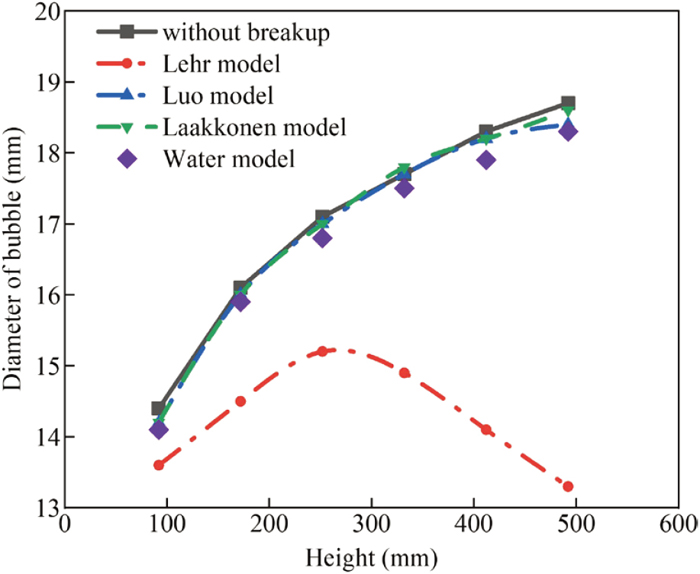
It can be seen that the bubble size distribution are similar when Luo model, Laakkonen model and no breakup model are considered, and they are similar to water model. But when Lehr model is considered, the bubble size distribution is different in Figs. 4 and 5. Therefore, Lehr model is not applicable, and the effect of bubble breakup behavior can be ignored in this work.
4.3. Influence of Bubble-induced TurbulenceThe turbulence of molten steel is the main factor to promote bubble breakup and coalescence behavior, and the accurate prediction of turbulence behavior of molten steel is the basis of reasonable description of bubble size distribution. In our previous work,26) the importance of bubble-induced turbulence on molten steel turbulence was discovered. In current work, the influence of bubble-induced turbulence on bubble size distribution was studied.
The effect of bubble induced turbulence Gb on the distribution of the flow field and the turbulence kinetic energy of liquid, as shown in Figs. 6 and 7. It can be seen from the figures that when bubble induced turbulence is considered, The turbulence kinetic energy of the molten steel in the center of bubbly plume will obviously increase, because some extra energy (from the energy of bubble floating) transform into turbulence, which also means that the kinetic energy directly obtained by molten steel (from the energy of bubble floating) will decrease, which will lead to a decrease in the velocity of molten steel, as shown in Fig. 7.

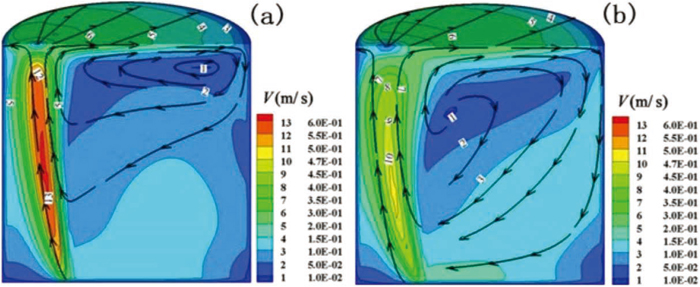
Figure 8 shows the influence of bubble-induced turbulence on bubble size distribution. As shown in Fig. 8, When bubble-induced turbulence is considered, the turbulence kinetic energy of liquid phase increases obviously, which makes the turbulence pulsation of liquid phase more intense, the random collision frequency of turbulence and the coalescence rate between bubbles increases.
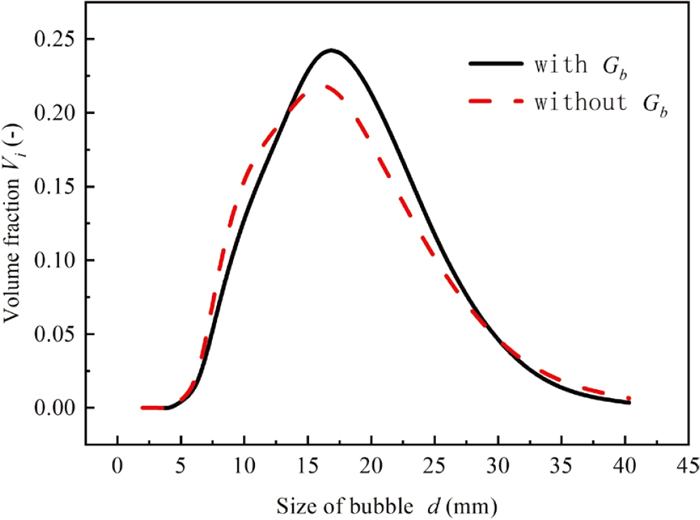
Figure 9 shows the comparison of gas holdup and sauter mean diameter d32 radial distribution predicted by mathematical model with the data measured by water model under different heights. It can be seen from the figure that the gas holdup distribution and local gas holdup obtained by the model are in good agreement with the measured data, and the Euler two-phase flow model is reasonable.
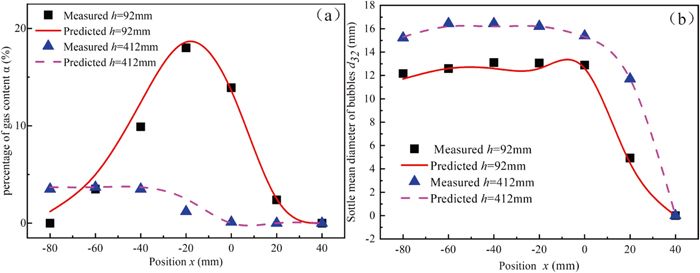
Figure 10 shows the comparison of real bubble diameter radial distribution between predicted results under different heights with measured data. As shown in the figure, the predicted results of the mathematical model are in good agreement with the measured data of water model, and the bubble coalescence behavior plays a leading role in successfully predicting the bubble size distribution of the gas-stirred ladle. The bubble population equilibrium model is reasonable.
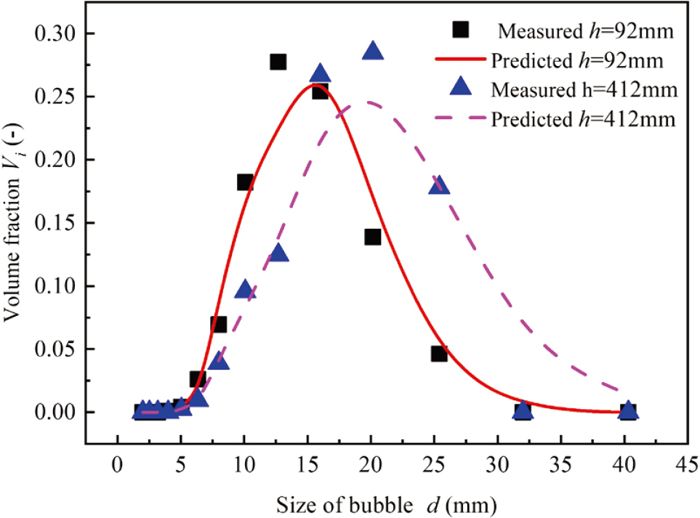
(1) In the gas-stirred ladle, the bubble coalescence behavior is mainly dominated by turbulence random collision, and bubble floating velocity difference collision and turbulence shear collision mechanism also have influence on it. The effect of turbulence shear collision mechanism can be ignored, so the bubble coalescence behavior is dominated by turbulence random collision and bubble floating velocity difference collision mechanism in the current system.
(2) In the gas-stirred ladle, the effect of Luo model, Lehr model and Laakkonen model on bubble size distribution are considered. When Luo model and Laakkonen model are considered, the bubble size distribution is similar to no breakup model considered and measured data in the water model; when Lehr model is considered, the bubble size distribution is different. The effect of bubble breakup behavior is small, and even can be ignored.
(3) When bubble-induced turbulence is considered, the turbulence kinetic energy of molten steel increases, the velocity of molten steel decreases. It can promote the bubble coalescence behavior, and the volume fraction ratio of large bubbles increases and small bubbles decreases, the bubble size distribution in gas-stirred ladle can be corrected.